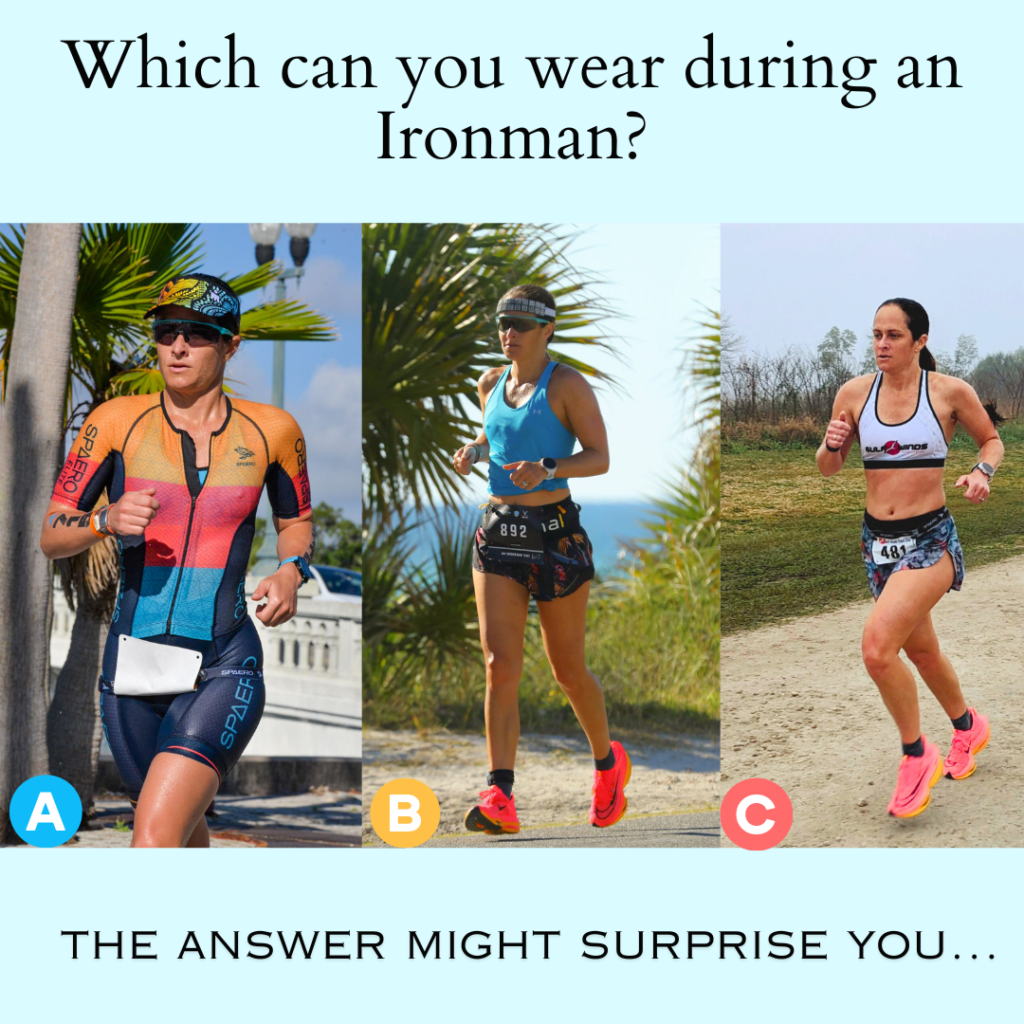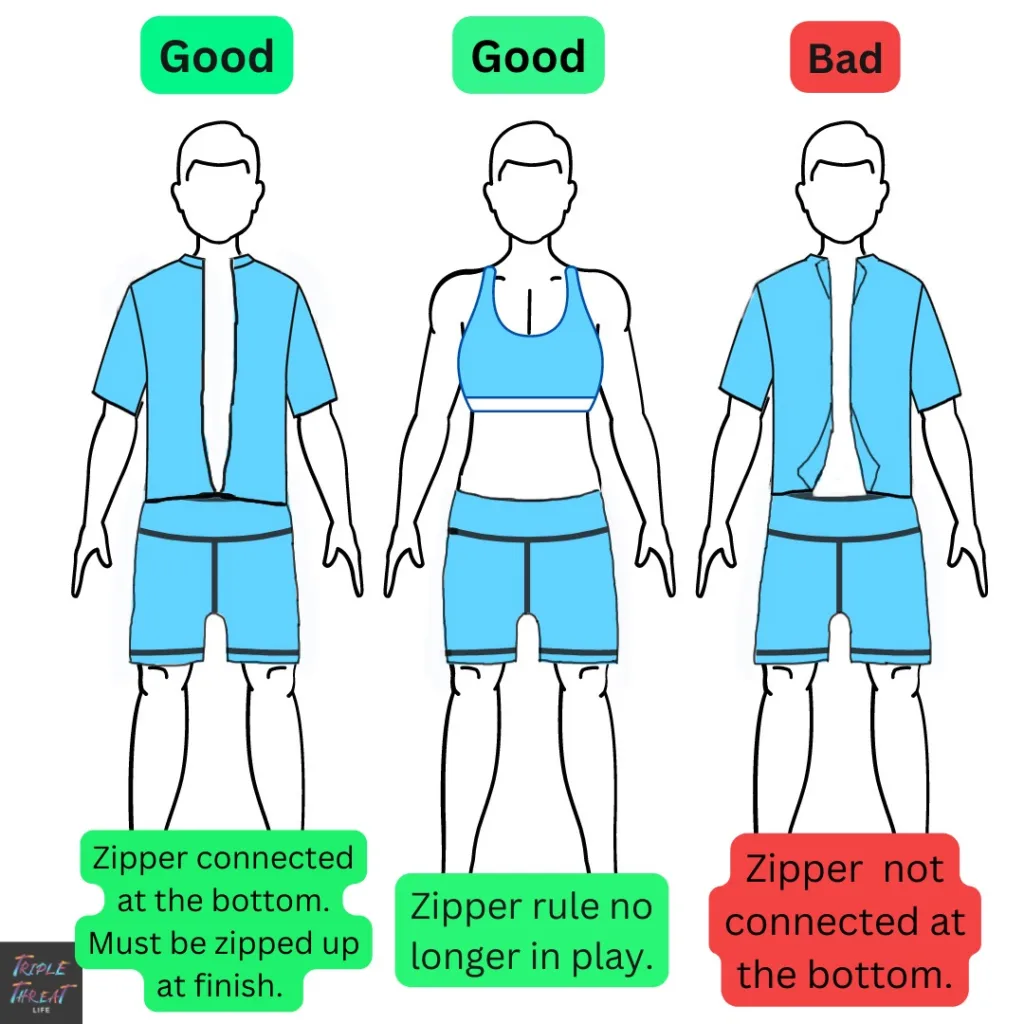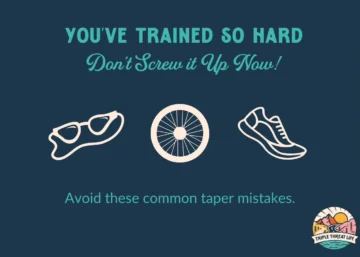
An important part of getting ready for a triathlon is deciding what to wear. And no, I’m not talking about fashion. I’m talking about functionality.
For example, some people like a tri-suit with sleeves for aerodynamics, while others like the sleeveless variety for warmer climates. Others are more comfortable in separates: a tri top with a pair of shorts. It’s really just a matter of personal preference.
But regardless of what you choose to wear, there are rules about how you can wear it, especially if you race at an Ironman event. You probably know where I’m going with this… the sometimes confusing and often controversial “zipper rule.” Luckily, my friend and head referee for Ironman, Jimmy Riccitello, is here to clarify, so you know exactly what you can and can’t wear at your next big race.
Where do these rules come from?
USA Triathlon (USAT) is the national governing body for triathlon in the United States. Their rules often align with the international standard of World Triathlon (ie. Olympic events) but may include some that are specific to USAT-sanctioned races. Similarly, Ironman follows rules set by World Triathlon, but they might also have some variations that are specific to their own races. You could extrapolate this out to other organizations as well, like Professional Triathletes Organization (PTO) and Challenge Roth.
While there are general rules that help guide the sport of triathlon, on a national and international level, organizations and events often have their own specific rules. That’s why you need to be very clear about the rules at the event where you plan to compete so you don’t risk a penalty, or worse, a disqualification.

What’s the zipper rule?
As far as the aforementioned “zipper rule,” here’s some background. Back in 2017, Ironman conformed with the then International Triathlon Union (ITU) rule that uniforms couldn’t be unzipped below the end of the breastbone or sternum. At that time, the penalty for not following the rule was disqualification.
The rule has since been amended, and, these days, the zipper can be unzipped to any length, provided that it stays attached at the bottom. This might benefit a triathlete competing in a hot climate where the additional air flow could help prevent overheating.
Also, the top of the uniform should cover the shoulders at all times, and the uniform should be fully zipped when crossing the finish line.
The most recent update to the rule came during the 2024 season, but the only portion that changed was the penalty, not the wording. Now, instead of the penalty being a disqualification, it’s a 30-60 second time penalty. But, it can progress to a DSQ (disqualification) if the uniform issue isn’t remedied promptly.
Let’s take a look at the actual wording of the zipper rule:
Section 6.01 e. Uniforms with a front zipper may be unzipped to any length, provided, that (i) the zipper should be connected at the bottom of the uniform at all times, and (ii) the top of the uniform should cover the shoulders at all times; (30 or 60 second time penalty, DSQ if not remedied properly.) The uniform should be fully zipped when crossing the finish line.
There’s another rule that relates to uniform. One appears in the cycling section of the Ironman rulebook and another in the running section, but the wording is essentially the same.
d. Running with a bare torso is prohibited. Athletes must wear a shirt, jersey, or sports top/sports bra at all times during the run segment of the race. (30 or 60 second time penalty, DSQ if not remedied properly.)
Basically, you can’t be running around a race topless. That makes sense. Nobody wants to see that. But, honestly, I’ve always been a bit confused as to how both rules relate to each other, and how they might apply to women, specifically. Here’s why.
What I was told as a beginner triathlete
I remember training for my first 70.3 (70.3 Chattanooga) back in 2021. I was doing a brick workout with a fellow female triathlete. Because it’s 100+ degrees in Florida in the summer, I had taken my arms out of my one-piece tri suit and rolled it down, so I was running in my sports bra and what essentially became shorts. She told me that while it was ok to do that in training, I shouldn’t do it during a race, because I might get disqualified.
As it turns out, she was wrong.
It’s not her fault, really. As the wording stands, the zipper and uniform rules can be a bit confusing, because it seems like there’s an underlying contradiction.
Apparently, you could have your tri-suit unzipped, as long as the zipper stays connected at the bottom and your shoulders are covered. But then, you could also wear a sports bra during the cycling or run segment. In that case, there’s obviously no zipper, but your shoulders wouldn’t be covered…
So that’s the big question: What if you wore a tri-suit with a zipper for the bike leg and then unzipped the top and rolled it down for the run (provided you had a sports bra on underneath)? Is that allowed?
Thankfully, my friend, Jimmy Riccitello, Global Director of Rules and Officiating for IRONMAN, is here to explain.
“Basically, if you have a uniform with a full zipper, it has to be connected at the bottom,” he says. “If you don’t have a uniform with a full zipper, then you need to have the [chest] covered. Whether you’re a male or a female, you can’t be topless.”
“To me, the top covering your shoulders means that you shouldn’t be racing in a tube top. If you’ve got a sports bra with straps that go over the shoulder, that’s ok. It doesn’t have to be completely covering the shoulder, like a short-sleeve shirt.”
That actually makes sense, because some athletes race in a sleeveless tri-suit where the shoulders aren’t completely “covered” either.
“We’re trying to allow athletes to have a bit broader choice when it comes to wardrobe. So, if you’re wearing a one-piece kit during the bike and want to use the bottom half as shorts, with a sports bra to cover your top, during the run, you can do that. A male or female can roll the top of the kit down to become shorts, and then the top becomes whatever you’ve got on underneath the suit. Once you’ve rolled it down, the zipper rule is no longer in play.”
If you want to see what this looks like in real-life, check out pro triathlete, Haley Chura, on Instagram (one of my favorites!). She often races while wearing her kit in this manner.
This also means that if an athlete wanted to do the bike portion of the race in a tri-suit with a zipper, and then change into shorts and a sports bra/top for the running portion of the race, he or she could do that as well.

To be clear, this is the same zipper and uniform rule from 2023, 2022, ect. The only thing that’s changed with the 2024 rule amendment is the penalty reduction. “The only thing that’s changed is we would like referees to first ask an athlete to connect the zipper at the bottom, rather than move immediately to disqualification,” he says.
Basically, it’s a softening of the penalty, so it’s meant to help athletes. And let’s be honest, as much as an athlete doesn’t want to be disqualified, a referee doesn’t want to do the disqualifying, unless they have no choice. “For a referee to pull the trigger on something like that, it takes careful contemplation,” he says. “It’s a decision that’s stressed over and, at the end of the day, they know they might receive a lot of grief for. But if they do nothing, there would be consequences for the next race.”
Now there’s an important caveat to keep in mind. Just because Riccitello has explained what the rule means, he’s not the referee at every single race. There have been instances of pro women being asked to pull up their kits and cover their sports bra (particularly overseas). In that case, the only thing you can do is comply. During a race isn’t the time to try to change someone’s mind. Make the adjustment that’s requested, and then you can deal with any potential protest when the race is over, if necessary.
Racing in World Triathlon is different
Keep in mind that this discussion doesn’t apply for any World Triathlon event; their uniform rules are much more strict. I won’t go into detail here, but they have rules about torso coverage, sleeves, midriff exposure, and zippers.
Click the links below to view the rules for different organizations:
World Triathlon Rules- https://www.triathlon.org/uploads/docs/World-Triathlon_Competition-Rules_2024_20240219.pdf
Ironman Rules – https://cdn1.sportngin.com/attachments/document/6a42-3158538/2024_IRONMAN_Competition_Rules_-_English_Version_March_14_2024.pdf
Hopefully, this helps to clarify the zipper rule as it pertains to sports bras, in particular. A big thank you to Jimmy for doing this interview while on his drive to Oceanside 70.3! He’s always been such a great advocate for athletes, especially when it comes to education about our sport.
Regardless of what you choose to wear during a triathlon, remember to take everything in stride.


